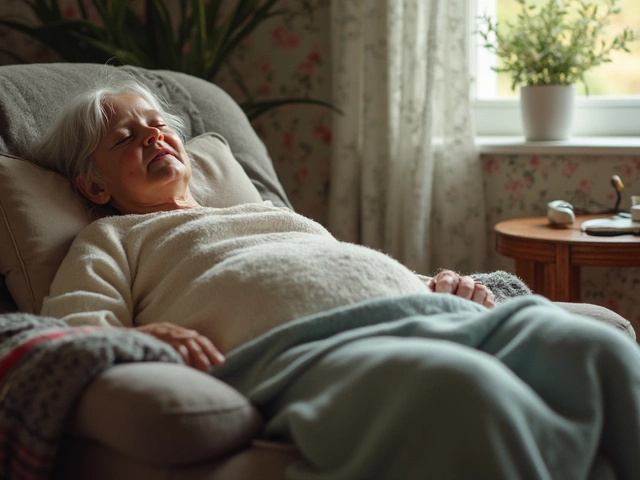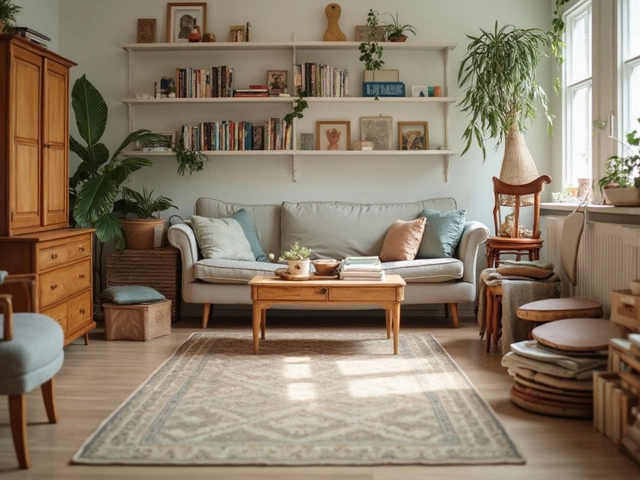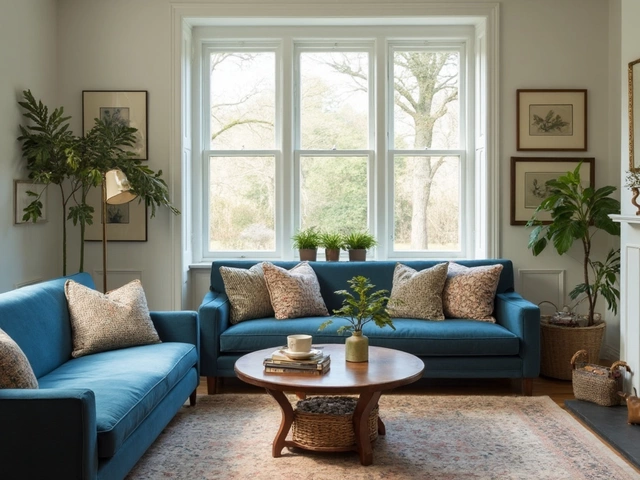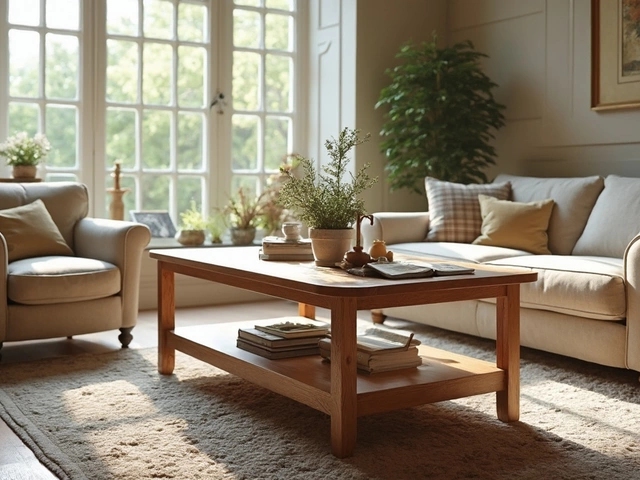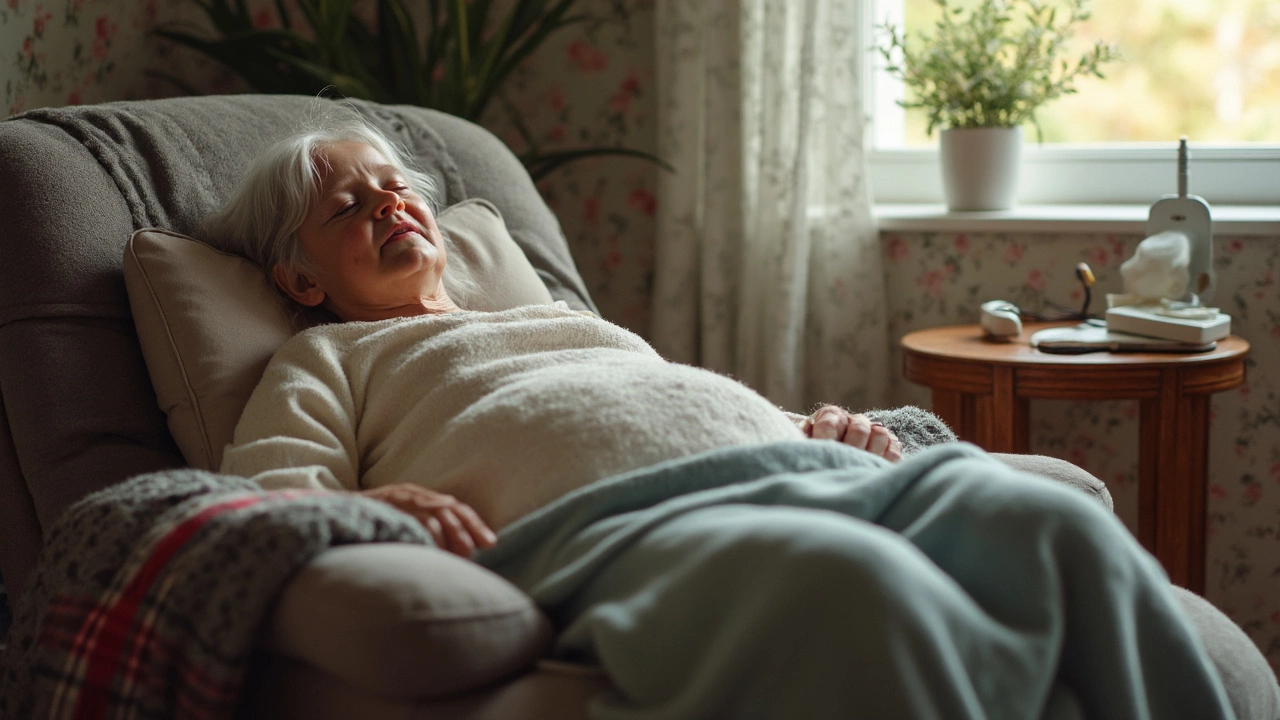 1
Jun,2025
1
Jun,2025
Ever wonder why your grandma or that neighbor down the hall spends the night in a recliner instead of a bed? It’s not just about comfort — for a lot of seniors, sleeping in a recliner is the only way they get any solid rest. People dealing with back pain, stiff joints, or even breathing troubles find it tough to lie flat. Recliners can help them breathe easier and reduce the achy feeling in their hips or knees.
But is it actually safe, or just the lesser evil compared to tossing and turning all night? That’s what most folks ask. Sure, a recliner might beat a bad mattress, but there are right and wrong ways to make it work. If you’re caring for an older parent or if you just can’t get comfy in bed anymore, it’s smart to learn what makes a recliner-friendly sleep spot safe and how to avoid the trouble spots — like messes with circulation or sore muscles from poor support.
- Why Do Seniors Choose Recliners for Sleep?
- Health Benefits and Relief from Sleeping Upright
- Risks and Downsides of Sleeping in Recliners
- How to Make Recliner Sleeping Safer and Comfier
- What to Look for in a Good Recliner for Sleeping
- Real-World Tips from Seniors and Caregivers
Why Do Seniors Choose Recliners for Sleep?
When you see an older adult snoozing in a recliner, there's usually a really good reason for it. Most seniors aren't just choosing this because it feels nice; it's often about real, daily challenges with sleep that a regular bed can't solve. The main issues? Chronic pain, breathing problems like sleep apnea or COPD, acid reflux, and trouble getting in or out of bed.
Here’s the thing: lying flat can make heartburn and breathing issues worse. Recliners let seniors keep their upper body slightly raised, which can stop acid from creeping up the throat and help air flow better. In fact, doctors often recommend this position for people with GERD or sleep apnea. And when arthritis or back pain isn’t letting you stretch out in bed, a well-padded chair feels like a much kinder option.
- Mobility problems - It can be a workout just to swing your legs into bed at night. Recliners are lower, stable, and easier to get in and out of.
- Better pain management - Joints and backs that hurt in the morning feel less stiff after a night in the right recliner.
- Independence - Some folks feel safer sleeping alone in a chair they control, especially if they risk falling when trying to get up at night.
- Quick naps or overnight recovery - Many seniors use their recliner for more than just sleep at night. It’s great for napping during the day, or after surgery and illness.
Check these numbers to see how common it is:
| Reason for Recliner Sleep | Percentage of Seniors Affected |
|---|---|
| Chronic pain | Up to 60% |
| Breathing conditions (COPD, sleep apnea) | About 30% |
| Acid reflux/GERD | Roughly 20% |
| Limited mobility | 45% |
The seniors who turn to recliners aren’t just doing it for comfort—they’re looking for a way to finally get a good night’s rest. Whether it’s convenience or a medical need, recliners end up being the go-to for a lot of older adults who struggle in a flat bed.
Health Benefits and Relief from Sleeping Upright
Sleeping in a recliner isn’t just a personal quirk—there are real health reasons behind it for a lot of older adults. When seniors sleep propped up instead of flat on a bed, they can actually make breathing a lot easier, especially for folks who deal with things like sleep apnea, COPD, or chronic heart failure. Lying flat can make it harder for airways to stay open. Raising the body just a bit (like in a recliner) can cut down on snoring and ease shortness of breath almost immediately.
Many seniors see a big drop in nighttime acid reflux, too. If you or someone you know constantly deals with heartburn after lying down, that’s no surprise. Gravity works in your favor when you’re lifted up, meaning less stomach acid creeps up the esophagus. Some doctors even suggest trying an upright position before reaching for daily medication.
Probably the biggest win comes for people with sore backs, hips, or knees. Recliners tip the legs up, take pressure off joints, and help blood flow—not just for comfort, but also to stop swelling and stiffness that makes mornings extra rough. There’s solid science behind this: a study from the Cleveland Clinic found that elevating the lower legs improves circulation and can help reduce swelling, especially in people with limited mobility.
- Breathing is easier for people with lung or heart conditions.
- Less acid reflux or heartburn overnight.
- Improved comfort for sore joints and muscles.
- Better circulation in legs when elevated.
| Condition | Benefit of Sleeping Upright |
|---|---|
| Sleep Apnea | Reduces airway collapse and snoring |
| Chronic Obstructive Pulmonary Disease (COPD) | Improves airflow and makes breathing easier |
| Acid Reflux / GERD | Stops acid from rising at night |
| Edema | Reduces leg swelling |
| Chronic Back Pain | Relieves pressure on the spine |
If you’re thinking about a recliner, make sure it’s got decent lumbar support and lets you raise your legs. That’s how you get the big benefits without waking up with a stiff neck or numb feet. While a recliner definitely brings comfort, talk with a doctor if you’re planning on using it as your main sleep spot—especially if you have serious medical problems. One thing’s for sure: for a lot of seniors, getting good rest in a recliner isn’t just possible—it’s a game-changer.
Risks and Downsides of Sleeping in Recliners
Kicking back in a recliner can seem like a dream, but there are real downsides—especially for seniors. Sleeping night after night in a chair instead of a bed brings its own set of problems, some of which can sneak up on you if you’re not paying attention.
One big issue is blood flow. Recliners may keep your legs bent, and when you’re in that position for hours, it increases the risk of swelling or even blood clots. Seniors are already at greater risk of blood clots from just being less mobile. A study from the American Journal of Medicine points to a 1.5x higher risk of leg clots in people who sleep sitting up for long periods compared to lying flat in a bed.
Here’s a quick run-down of what else could go wrong with too much recliner-snoozing:
- Seniors may wake up stiff or sore, especially around the neck, back, or hips, from poor body alignment.
- Deep sleep takes a dive if your body can’t fully relax. It’s harder to hit those deep sleep cycles in a chair.
- Pressure sores can develop if the recliner isn’t padded well or you don’t move around during the night. This is a big deal for folks who already have limited mobility.
- Getting in and out of a recliner while sleepy is more dangerous than it sounds. Slips, trips, or even falls can happen, especially if you’re trying to stand up without being fully awake.
- If the recliner doesn’t recline all the way, circulation in your lower legs gets worse, leading to numbness, tingling, or swelling.
Snoring and breathing trouble aren’t always fixed by sleeping upright. Some people actually notice more dryness in their mouth or throat because their mouth hangs open, making sleep less refreshing. And it’s tough if you’re a tosser and turner—recliners just don’t offer room to move around the way a bed does.
Here’s a side-by-side look at what might go wrong when you trade your mattress for a recliner all night long:
| Risk | How It Affects Seniors |
|---|---|
| Poor Circulation | Swollen feet, higher risk of blood clots |
| Stiffness/Soreness | Neck, back, and hip pain from lack of support |
| Pressure Sores | Higher chance, especially for those with limited mobility |
| Falls | More slips or trips when getting in/out while groggy |
| Poor Sleep Quality | Less deep sleep, more morning grogginess |
The takeaway? Recliners aren’t a cure-all. If someone needs to sleep in one for more than a few nights, it’s a good idea to talk with a doctor or physical therapist. Little tweaks—like adding a footrest, rolling over occasionally, or using cushions for extra support—can make a world of difference.

How to Make Recliner Sleeping Safer and Comfier
If you or a loved one is sleeping in a recliner, there are some tricks and must-dos to stay comfortable and avoid problems like leg swelling, pressure sores, or muscle cramps. Getting this setup right helps a ton with actual rest and keeps common senior sleep issues in check.
Let’s start with posture. Your back and neck need support. Grab a lumbar cushion or simply roll up a towel for your lower back. A memory foam pillow or a travel pillow can keep your head from tilting at weird angles. Don’t forget about your legs—keep them slightly bent unless your doctor says otherwise, and use a small pillow under your knees if it feels better.
- Wear compression socks if you notice swelling in your feet or ankles, but check with your doctor first.
- Set a timer to change positions every few hours, just like you would in bed. Even a small shift can prevent stiffness.
- Keep a water bottle by your side to stay hydrated—recliners can make you sweat more than you think, especially with a blanket on top.
- If you deal with acid reflux, try sleeping with the chair at a slight angle instead of fully flat to keep stomach acid down.
Cleanliness matters too. Crumbs and sweat collect faster in a recliner than on a bed. Wipe down the chair every week with a gentle cleaner and wash any covers or pillows you use. This cuts down on germs and keeps allergies under control.
Here’s a quick look at common tips and their benefits for seniors who sleep in recliners:
| Tip | Benefit |
|---|---|
| Use extra pillows | Better support for head and back |
| Wear compression socks | Reduces risk of swollen ankles |
| Shift positions | Prevents soreness and pressure points |
| Stay hydrated | Avoid dry mouth and dehydration |
| Clean regularly | Reduces germs and skin problems |
Last thing—if you ever feel numbness, tingling, or intense pain while sleeping in a recliner, talk to your doctor. These could be signs it's time for a new approach. A few easy changes can keep recliner sleeping safe and comfy, night after night.
What to Look for in a Good Recliner for Sleeping
If you want a recliner that’s good enough for regular sleep, don’t just grab the first one at the furniture store. There’s a massive difference between a basic TV-watching chair and a real sleep-friendly recliner. Here’s what matters most:
- Seniors need great lumbar support. The chair should support the lower back all night so you don’t wake up stiff or sore.
- Look for adjustable positions, especially one that lets you go nearly flat. Full recline is way better than just a small angle, especially for back or hip pain.
- Easy-to-use levers or buttons make a big difference. If you’ve got arthritis or weak hands, complicated controls are a no-go. Power recliners with remote controls are much simpler for folks with mobility issues.
- Wide armrests and sturdy construction can prevent slips and help with getting up safely.
- Check for spill-proof and easy-to-clean fabric. Accidents happen, and you want cleanup to be quick.
- Some recliners have “lift” features that actually help you stand up. This is a huge help if joints or strength are an issue.
Want a quick side-by-side of features and what they mean for sleep? Here’s a handy breakdown:
| Feature | Why It Matters |
|---|---|
| Full Recline (Near Flat) | Supports multiple sleep positions and eases pain |
| Lumbar Support | Prevents lower back soreness and stiffness |
| Power/Lift Mechanism | Makes standing up safer and less stressful |
| Easy Controls | Simple operation for shaky or weak hands |
| Washable/Breathable Fabric | Keeps skin cool and cleanup easy |
| Sturdiness/Stability | Reduces risk of tipping or falling |
Before you buy, always test the recliner if you can. Sit in it for at least 10–15 minutes, try the controls, and see how it feels on your back and legs. If it isn’t easy to move or adjust, or leaves your back sagging after a while, that’s not the one. A good sleep recliner isn’t cheap, but being able to actually rest through the night? That’s worth every penny.
Real-World Tips from Seniors and Caregivers
Seniors who actually sleep in recliners, and their caregivers, have figured out what works best through trial and error. Here’s what people living with this every day say helps—plus a few numbers to show what’s actually going on.
The seniors who are most comfortable overnight in a recliner always have the basics in place: soft, but supportive pillows and a blanket within reach. Many put a rolled towel or small pillow behind their lower back for more lumbar support. Some swear by putting a thin foam pad or old comforter over the chair for extra cushion, especially if their chair’s seat is a bit firm or not designed for overnight sleep.
If swelling in feet is an issue, people recommend keeping feet slightly elevated—just not too high. Too steep an angle and you can get hip or knee pain. Several folks also mentioned setting an alarm to shift position at least once or twice in the night. Even just changing which side you lean can help your circulation.
- Keep water nearby to avoid getting up in the night.
- Have a small nightlight so you don’t trip.
- Put a TV tray or table next to the chair for meds, reading glasses, or a phone.
- Drape a sheet over the recliner or use a washable cover for easy cleanup.
Caregivers talk about making sure the recliner isn’t too hard to operate. Electric recliners with simple remote controls are way easier for folks with arthritis in their hands. Some recliners also lock into position, so the angle doesn’t slip during the night—a big worry if you’re afraid of sliding out of the chair.
If you want to know how common this really is, check this out:
| Age Group | Reported Sleeping in Recliners Regularly (%) |
|---|---|
| 65-74 | 18 |
| 75-84 | 27 |
| 85+ | 32 |
(Data from a 2023 survey by the National Council on Aging)
Probably the most common tip? Don’t ditch your regular bed entirely, if you can help it. Most people rotate between the recliner and the bed. They say this helps with stiffness and makes it less likely you’ll develop sore spots or aches in the same place night after night.
